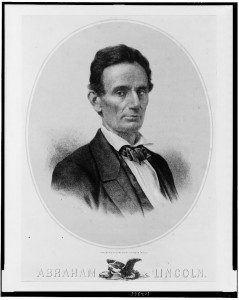 Abraham Lincoln in 1850, the year after he represented George D. Berry in a lawsuit. Lithograph by Edw. Mendel, Library of Congress Prints and Photographs Division, LC-USZ62-102366.
Abraham Lincoln in 1850, the year after he represented George D. Berry in a lawsuit. Lithograph by Edw. Mendel, Library of Congress Prints and Photographs Division, LC-USZ62-102366.
My husband inherited several dozen Civil War–era letters from his great-great-grandmother Susan (Berry) Dill and her daughter, Ida Alice Dill, who lived in Sangamon and Christian Counties, Illinois. Ida married Frank Stratton, the brick wall in my husband’s ancestry. One day, in frustration at not finding anything about Frank, I took to Google and entered a string of names and dates from the letters: George Elizabeth Susan Benjamin Berry Christian County Illinois 1850 1860—something like that. If no clue to Frank turned up, I figured, I would learn more about the Berrys. And indeed I did.
One hit was from a historic autograph site, selling a document from November 1849: a bill of complaint re George D. Berry v. John S. Cagle. George had sued Cagle for trespass, as Cagle had caused his daughter Elizabeth “to bear an illegitimate child and be sick for nine months.” Elizabeth’s siblings were asked to be witnesses—which is why my whole string of names yielded this hit. I read farther. The document was signed by Abraham Lincoln. The Berrys had hired him as a lawyer.[1]
We already had a family story about Lincoln. Frank Stratton allegedly installed the heating system at Lincoln’s Tomb at Springfield, saying, “It took a Johnny Reb to heat old Abe’s bones.” (Born in South Carolina, Frank claimed to have fought for the Confederacy.) But there was no lore passed down about the family’s hiring of Lincoln as a lawyer. Illegitimate birth was apparently a taboo topic.
Before embarking on his political career, Lincoln owned a general store with William Berry; so far I haven’t determined a relationship between William Berry and George D. Berry. It’s fun to imagine, though, that when George wanted legal help he thought, “I’m going to ask cousin William. I hear his former business partner is a lawyer.”
Like many family historians, I like to see how individual stories intersect with larger historical events. At the time of the lawsuit, Lincoln had already served in Congress; he had returned home to Illinois in May 1849, “happy to be reunited with his friends and family.”[2]
And although we know of no further contact between my husband’s ancestors and the future president, it’s easy to imagine their interest in their lawyer over the next decade. On October 16, 1854, a month before Susan Berry married Ezra Dill, Lincoln gave an antislavery speech at Peoria, reviving his political career. In 1857, five months after Susan gave birth to Ida and about a week before Ezra died at age 23, Lincoln gave a speech in Springfield opposing the Dred Scott decision; the next year he gave his famous “House Divided” speech. In 1860, the year he was elected president, the widow Susan and her two children were living with her parents in Christian County. In some of her letters preserved from 1862, we see Susan was being courted by Civil War soldiers. But given the nature of the 1849 lawsuit, it’s not surprising that no letters refer to the events that linked her family to the sixteenth president.
Frank Stratton: still a brick wall. But thank goodness I decided to put that long string of names and dates into Google!
Notes
[1] The document is described in Abraham Lincoln Sesquicentennial 1959, an exhibit catalog published by the Lincoln Sesquicentennial Association of California in conjunction with an exhibit at the Los Angeles County Art Museum, viewable online at https://archive.org/details/abrahamlincolnse00illinc. George Berry’s visit to Lincoln, on September 13, 1849, is recorded at the Lincoln Log website, www.thelincolnlog.org, and at “Lincoln/Net,” website of the Abraham Lincoln Historical Digitization Project at Northern Illinois University, http://lincoln.lib.niu.edu.
[2] “Congressman Lincoln 1847–1849,” Lincoln Home National Historic Site, nps.gov/liho/historyculture/congressman.htm.
Share this:
About Penny Stratton
A veteran of the book publishing industry, Penny Stratton retired as NEHGS Publishing Director in June 2016; she continues to consult with the Society on publications projects. Among the more than 65 titles she managed at NEHGS are The Great Migration Directory, Elements of Genealogical Analysis, Genealogist’s Handbook for New England Research, and the award-winning Descendants of Judge John Lowell of Newburyport, Massachusetts. She has written for American Ancestors magazine and is a regular poster on Vita Brevis. With Henry B. Hoff, Penny is coauthor of Guide to Genealogical Writing: How to Write and Publish Your Family History; she is also the author of several Portable Genealogists on writing and publishing topics.View all posts by Penny Stratton →